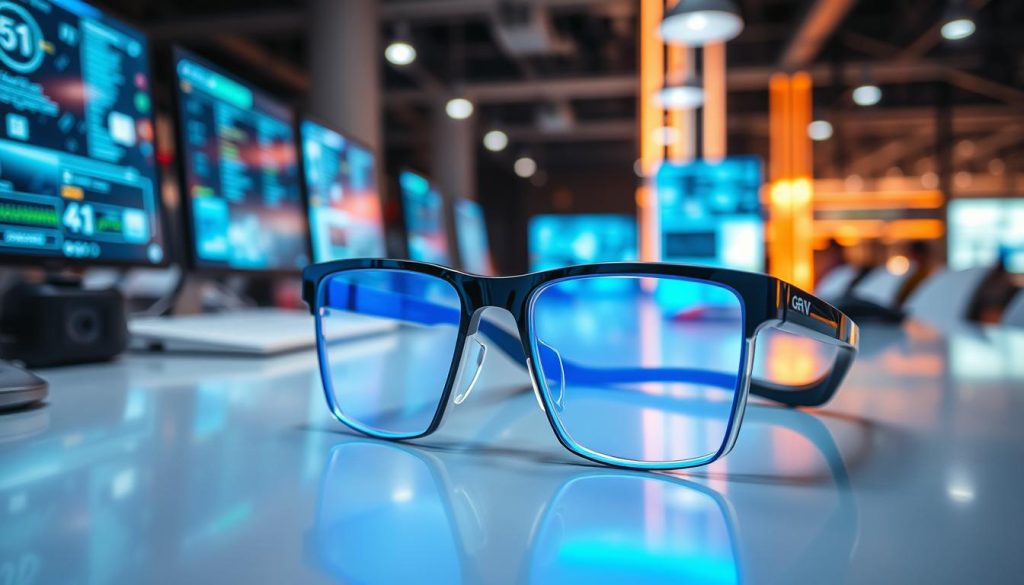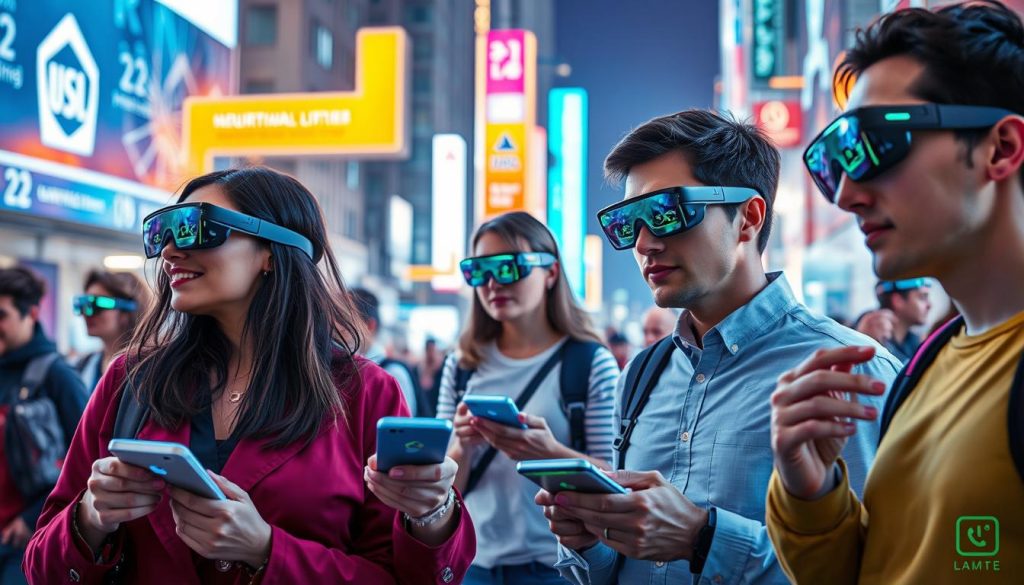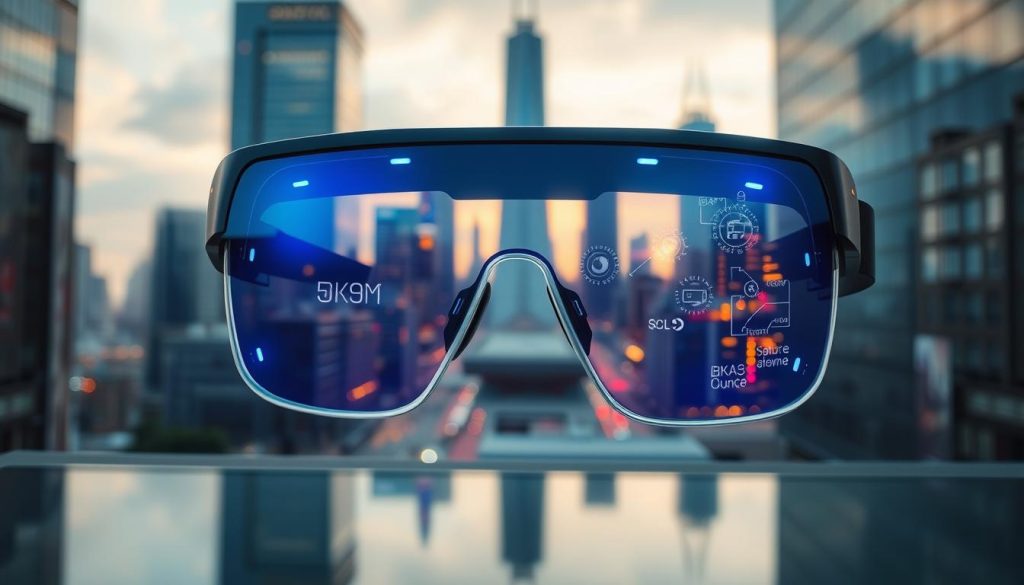The world is moving fast into the digital age. Wearable technology is changing a lot, with smart glasses leading the way. These devices will change how we see and interact with the world around us.
Reports show the global smart glasses market is growing fast. The International Data Corporation (IDC) says there was a big drop in AR/VR headset sales in Q1 2024. But, people are now looking for smart glasses that are easier to use.
ResearchAndMarkets says the smart glasses market grew to about 678,600 units in 2023. They predict it will jump to 13 million units by 2030. This is a growth rate of 53.0% each year from 2023 to 2030.
More people are using smart glasses because of new technology. Big names like Google, Meta, Snap, and others are making these glasses better. Now, you can find everything from simple Bluetooth glasses to advanced AR glasses.
Key Takeaways
- The global smart glasses market is experiencing exponential growth, with a projected increase to 13 million units by 2030.
- Technological advancements have led to a diverse range of smart glasses offerings, from basic Bluetooth-enabled models to advanced AR solutions.
- Major tech companies, such as Google, Meta, and Snap, are driving innovation in the smart glasses space, making them increasingly accessible and appealing to consumers.
- The shift in consumer preferences from traditional AR/VR headsets to more versatile smart glasses is a clear indication of the technology’s growing popularity and mainstream acceptance.
- The integration of AI and voice command features in smart glasses is further enhancing their functionality and user experience, positioning them as the next major technology platform.
The Evolution of Smart Eyewear Technology
Smart eyewear has grown a lot since Google Glass came out in 2013. What started as a dream has turned into something that’s both smart and stylish. The path from Google Glass to today’s tech has seen many important steps. These steps have shaped the industry and led to today’s top brands and their latest tech.
From Google Glass to Modern Innovation
Google Glass was a big step forward but faced issues like privacy worries and a bulky design. Yet, it sparked a wave of new ideas. Now, companies like Snap Inc. and Vuzix offer a wide range of smart glasses. They meet different needs and tastes.
Key Milestones in Smart Glasses Development
- In 2013, Google introduced Google Glass, marking the emergence of smart glasses in the technology market.
- Snap Inc. released Spectacles, glasses with a focus on social media and creativity, showcasing the diversification of smart glasses’ applications.
- Companies such as Vuzix and Epson concentrated on producing augmented reality glasses for professional and business users.
- Google released an updated version of Google Glass called Google Glass Enterprise Edition, tailored for business applications in hospitals and factories.
Current Market Leaders and Innovations
Today, leaders like Meta (formerly Facebook) and Snap Inc. are at the top. They’ve made smart glasses that are both cool and useful. They’ve added cool features like augmented reality and voice control. This makes smart glasses more valuable in work and everyday life.
| Company | Product | Key Features |
|---|---|---|
| Meta (Facebook) | Ray-Ban Stories | Forward-facing cameras for capturing photos and videos, built-in speakers, and hands-free voice control. |
| Xreal | Xreal AR Glasses | Augmented reality capabilities, seamless integration with mobile devices, and a focus on productivity and entertainment. |
| Snap Inc. | Spectacles | Emphasis on social media and creativity, with features like hands-free video recording and image sharing. |
Understanding Smart Glasses Categories
Smart glasses are becoming a big deal in wearable tech. They offer a wide range of features for different needs. Let’s explore the main types of smart glasses that are changing the game.
Basic Bluetooth-Enabled Glasses
Basic Bluetooth-enabled smart glasses are great for phone accessories. Brands like Amazon Echo Frames and Bose Frames give you hands-free audio. They work with virtual assistants for voice commands and wireless calls.
These glasses make it easy to use your phone without touching it. You can take calls, listen to music, and more.
AR-Enabled Smart Glasses
AR-enabled smart glasses take it up a notch. They add digital info and visuals to the real world. This creates an amazing augmented reality experience.
Brands like Xreal Air 2 and Microsoft HoloLens show off cool features. They offer holograms, 3D models, and more. It’s like stepping into a new world.
AI-Integrated Eyewear Solutions
AI-integrated eyewear is leading the way. Brands like Ray-Ban, with Meta, are at the forefront. They use AI for cool features like image recognition and voice commands.
These smart glasses use AI to make your life easier. They open up new possibilities in wearable tech.
The smart glasses market is growing fast. You’ll see more features, designs, and functions soon. Whether you want hands-free use, AR fun, or AI smarts, there’s something for everyone.
| Smart Glasses Category | Key Features | Example Brands |
|---|---|---|
| Basic Bluetooth-Enabled Glasses | Hands-free audio, voice controls, wireless connectivity | Amazon Echo Frames, Bose Frames |
| AR-Enabled Smart Glasses | Augmented reality overlays, 3D holograms, interactive content | Xreal Air 2, Microsoft HoloLens |
| AI-Integrated Eyewear Solutions | Image recognition, multilingual support, voice commands | Ray-Ban x Meta |
Leading Brands and Their Smart Glass Solutions
The smart glasses market is growing fast. Brands like Xreal are leading with their Air and Air 2 models. These offer high-resolution displays and immersive augmented reality (AR) experiences.
Ray-Ban Meta is another big name. It’s a partnership between EssilorLuxottica and Meta. It combines classic style with advanced AI features.
Amazon’s Echo Frames also stand out. They focus on smooth audio and Alexa voice control. Other brands like Vuzix, Lucyd, and Snap with Spectacles offer unique features for different users.
| Brand | Key Features | Target Market |
|---|---|---|
| Xreal | High-resolution displays, AR capabilities | Consumers, enterprise |
| Ray-Ban Meta | Classic style, AI integration | Fashion-conscious consumers |
| Amazon Echo Frames | Audio integration, Alexa voice control | Consumers, smart home enthusiasts |
| Vuzix | Industrial-focused AR solutions | Enterprise, industrial users |
| Lucyd | Affordable smart glasses with basic features | Consumers on a budget |
| Snap Spectacles | Social media integration, camera functionality | Younger, tech-savvy consumers |
These brands show the variety and innovation in smart glasses. They meet many user needs and preferences. As technology advances, we’ll see even more exciting developments.

AI Integration and Voice Command Features
Smart glasses are changing from just fashion items to high-tech tools. They now use artificial intelligence (AI) and voice commands. This makes them easier to use and more helpful than ever.
Meta AI and ChatGPT Integration
The new smart glasses, like the Ray-Ban Meta, have cool AI features. You can ask them about what you see, thanks to Meta’s AI and ChatGPT. Since they came out, millions of moments have been shared, helping users remember things like where they parked.
Multilingual Support and Translation Features
Smart glasses can now understand and translate different languages. They can handle Spanish, French, and Italian, among others, in real-time. This is great for travelers, professionals, and anyone who needs to communicate across languages.
Voice Control Capabilities
Voice control makes smart glasses super convenient. You can use them without your hands, thanks to advanced voice tech. You can dictate messages, get directions, and set reminders just by talking to them. This technology is changing how we use our wearable devices in many areas, like warehouses and healthcare.
As smart glasses get better, they will change how we use our tech even more. The mix of AI, voice commands, and virtual assistants is making our lives more efficient and connected.
Display Technologies and Visual Experience
Smart glasses are getting better, thanks to advanced display tech. Waveguide systems and Micro-OLED panels make them visually stunning.
The XREAL Air 2 uses Micro-OLED for a full HD display at 120Hz. This means a smooth, immersive experience for work, fun, or everyday tasks. The Rokid Max smart glasses offer a virtual screen up to 215 inches, giving a wide view for different uses.
Some smart glasses offer a small heads-up display. Others aim for a full AR experience with waveguide displays. These displays mix virtual and real worlds, creating an engaging visual journey.
But, making these displays the right size and quality is hard. It’s important to find a balance between screen size, quality, and comfort. This ensures a good experience with smart glasses.
“The new holographic augmented reality system developed by researchers offers a more compact 3D display compared to existing technologies, overcoming technical barriers through a combination of AI-enhanced holographic imaging and new nanophotonic device approaches.”
As smart glasses improve, we’ll see new display tech and experiences. This will change how we interact with digital worlds.
Smart Glasses in Daily Life Applications
Smart glasses are now a part of our everyday lives. They come with advanced tech like augmented reality (AR) and virtual assistants. This changes how we see and interact with our surroundings.
Professional Use Cases
In work settings, smart glasses are very useful. They help in fields like manufacturing, logistics, and field services. They give us access to important info and support without using our hands.
In healthcare, they let doctors see patient records and work more accurately. This makes work safer and more precise.
Entertainment and Gaming
Smart glasses are also changing how we enjoy entertainment and games. We can dive into virtual worlds and play AR games. They even offer a new way to watch movies.
Features like eye tracking make gaming and fun activities even better. It’s a new way to engage with digital content.
Health and Fitness Tracking
Smart glasses also help with health and fitness. They work with apps and sensors to track our heart rate and activity. This helps us stay healthy and fit.
Smart glasses are versatile and fit into many parts of our lives. They improve work, fun, and health. They’re changing how we use technology and interact with the world.

Privacy and Security Considerations
Wearable tech like smart glasses is getting more advanced. This means data privacy and security are more important than ever. These devices have cameras, microphones, and AI, raising worries about unauthorized recording and data misuse.
Companies like Meta (Facebook) are trying to fix these problems. The new smart glasses have visible recording lights and need your okay to record. They also have secure ways to handle your data to keep it safe from hackers.
But, these smart glasses are complex. Users need to watch their privacy settings closely, especially in public. With Meta and Ray-Ban’s AI upgrade for their smart glasses in April 2024, keeping your data safe is more important than ever.
Other wearable tech like smart watches and rings also raise privacy and security concerns. It’s key for users to know what data these devices collect and how it’s used. They should also understand the laws that protect their personal info.
“The product’s website highlights features emphasizing privacy, including LED notifications when the camera is in use. Users are cautioned to use the product responsibly, such as turning the device off in private spaces.”
As more people use smart glasses and other wearables, it’s vital for everyone to work together. We need strong data privacy and security rules to protect our personal info and rights.
The Impact on Retail and Shopping Experience
Smart glasses are changing the retail world. They mix virtual and real shopping in a new way. This tech lets people see prices and products easily, changing how we shop.
Virtual Shopping Integration
With smart glasses, you can look at digital catalogs without using your hands. You can see how products look in your space with augmented reality. This helps you decide what to buy.
Real-Time Price Comparisons
Smart glasses with virtual shopping let you check prices by scanning items. This gives you quick access to prices. It helps you find the best deals, making shopping better.
Digital Catalog Access
Mixed reality in smart glasses means easy access to digital catalogs. Retailers can show more items, even if they’re not in-store. This makes shopping more fun and interactive.
As smart glasses get better, shopping will change a lot. It will mix the real and digital worlds. This will make shopping more fun and personal for everyone.
| Key Insights | Statistics |
|---|---|
| Augmented reality glasses are predicted to bring a renaissance in physical retail by merging digital and physical shopping experiences. | The AR-in-retail market size was valued at $2 billion in 2021, and the AR market is estimated to grow at a CAGR of 41.4% from 2022 to 2031, reaching $61.3 billion in 2031. |
| Hands-free, contactless payments with AR glasses will eliminate the need for wallets or phones in-store. | Only about 1% of retailers are currently experimenting with AR technology. |
| Personalized recommendations in physical retail through AR glasses will lead to a more engaging shopping experience. | The global VR-in-retail market is projected to reach $5.455 billion by 2028, with a growth rate of 13.82% from 2022. |
Conclusion
Smart glasses are changing the game in wearable tech. They promise a new way to interact with our digital world. From simple Bluetooth glasses to advanced AR and AI models, the progress is amazing.
These glasses are getting better at mixing function, style, and design for users. We’ll see better displays, smarter AI, and easier use in our daily lives. They could change how we use digital tools, from voice commands to augmented reality.
But, we must think about privacy and security. New solutions and careful policies are key. As more people use smart glasses, the industry will keep improving. This tech could change how we see and interact with the world.
FAQ
What are smart glasses and how do they work?
What are the different types of smart glasses available?
What are the key features and capabilities of smart glasses?
What are some of the leading brands in the smart glasses market?
How do privacy and security concerns affect the use of smart glasses?
How can smart glasses impact retail and shopping experiences?
What is the future outlook for smart glasses technology?
Source Links
- Exploring the 2025 Future of AR Smart Glasses – XR Today – https://www.xrtoday.com/augmented-reality/exploring-the-2025-future-of-ar-smart-glasses/
- The Best Smart Glasses for 2024 – https://www.pcmag.com/picks/the-best-smart-glasses
- AI-Enhanced Next-Gen Smart Glasses Could Revolutionize Wearables – https://www.technewsworld.com/story/ai-enhanced-next-gen-smart-glasses-could-revolutionize-wearables-179339.html
- The Evolution of Smart Glasses: From Fashion to Function – https://blog.emb.global/evolution-of-smart-glasses/
- The Comprehensive History of Smart Glasses – https://capsulesight.com/smartglasses/the-comprehensive-history-of-smart-glasses/
- The Evolution And Future Of Smart Glasses | VisionPlus Magazine – https://visionplusmag.com/article/the-evolution-and-future-of-smart-glasses-3/
- Introduction to Smart Glasses — 2024 Tech Review – https://medium.com/antaeus-ar/introduction-to-smart-glasses-2024-tech-review-d871e7d95cb8
- Navigating the World of Smart Glasses: A Comprehensive Guide – https://www.medicaleyecenter.com/2024/01/03/world-of-smart-glasses/
- Smart Glasses Companies – Top Companies List of Smart Glasses Industry – https://www.marketsandmarkets.com/ResearchInsight/smart-glasses-companies.asp
- Top Smart Glasses companies | VentureRadar – https://www.ventureradar.com/keyword/Smart Glasses
- Ray-Ban | Meta Glasses Are Getting New AI Features and More Partner Integrations | Meta – https://about.fb.com/news/2024/09/ray-ban-meta-glasses-new-ai-features-and-partner-integrations/
- New Ray-Ban | Meta Smart Glasses Styles and Meta AI Updates | Meta – https://about.fb.com/news/2024/04/new-ray-ban-meta-smart-glasses-styles-and-meta-ai-updates/
- Voice-enabled smart glasses – Vivoka – https://vivoka.com/use-cases/smart-glasses/
- Augmented reality comes to regular glasses – https://news.stanford.edu/stories/2024/05/3d-augmented-reality-with-regular-glasses
- The Future of Smart Glasses: Predictions and Emerging Technologies – https://www.marketsandmarkets.com/blog/SE/future-smart-glasses
- The Best Smart Glasses To Experience the Future Now – https://www.popularmechanics.com/technology/gadgets/a44067373/best-ar-smart-glasses/
- What are smart glasses and how do they work? | Nsflow – https://nsflow.com/blog/what-are-smart-glasses
- A look into the future through smart glasses – NDS – https://newdigitalstreet.com/a-look-into-the-future-through-smart-glasses/
- Technology: ‘smart’ glasses and similar wearables pose privacy and security challenges – https://www.ibanet.org/Technology-smart-glasses-pose-privacy-and-security-challenges
- Facebook smart glasses: Understanding the privacy risks – https://nordvpn.com/blog/facebook-smart-glasses/
- How AR glasses will revolutionize the buying experience in physical retail environments – https://www.retailcustomerexperience.com/blogs/how-ar-glasses-will-revolutionize-the-buying-experience-in-physical-retail-environments/
- 10 Pros and Cons of Smart Glass for Retail Spaces – https://www.smartfilmsinternational.com/post/pros-and-cons-of-using-smart-glass-for-your-retail-shop
- Smart shopping: AR and VR in retail – https://www.business-reporter.co.uk/management/smart-shopping-ar-and-vr-in-retail
- Defining Smart Glasses: A Rapid Review of State-of-the-Art Perspectives and Future Challenges From a Social Sciences’ Perspective – Augmented Human Research – https://link.springer.com/article/10.1007/s41133-021-00053-3
- Ray-Ban Stories Smart Glasses: A Tech Marvel or Just a Gimmick? – https://www.hireawriter.us/business/ray-ban-stories-smart-glasses-a-tech-marvel-or-just-a-gimmick
- AI-Powered Smart Glasses: Enhancing Lives of the Visually Impaired and Deaf – TT CONSULTANTS – https://ttconsultants.com/ai-powered-smart-glasses-enhancing-lives-of-the-visually-impaired-and-deaf/


